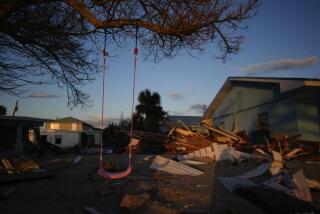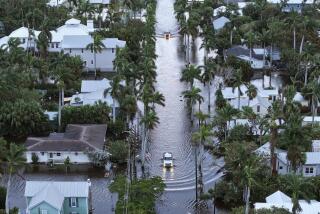Florida Beach Town Pays the Price of Development : Storm: Southerners transformed once-sleepy village of Destin into a prime resort. Now, much of it has been blown away by Hurricane Opal.
DESTIN, Fla. â Like moths drawn to a flame, the elite of Southern society flock to this tiny sliver of pristine beachfront, building their million-dollar condos as close as structurally possible to the emerald waters that lap the sugary sands.
Over the last decade, vacationers from Alabama and Georgia and Tennessee have transformed Destin from a sleepy fishing village into the crown jewel of the Florida Panhandle. But their seemingly insatiable appetite for seaside property also has pushed Destin to its coastal limits, leaving this narrow resort community increasingly vulnerable to the Gulf of Mexicoâs stormy tides.
âItâs like playing roulette, I guess,â said Richard Carroll, a 61-year-old surgeon from Birmingham, Ala., who owns a palatial eleventh-floor condominium with a panoramic ocean view.
On Wednesday, as Hurricane Opal tore across the dozens of small barrier islands that shield the Florida mainland from the sea, Destinâs gamble came up a loser. Pummeled by 100-m.p.h.-plus gusts and a 20-foot tidal surge, virtually every waterfront property was flushed into ruins by a brackish wall of surf and sand.
Cars floated out of garages. Boats flew onto the shore. Roads buckled under the waves. Dunes disintegrated in the wind.
âItâs about as bad as you could imagine,â said Carroll as he trudged up the darkened stairwell of the Regency Towers, whose front doors were blown out and replaced by a hip-high sand drift. A Mercedes-Benz automobile teetered precariously in a muddy pond. Dead fish lay scattered along the driveway. The wooden walkway that once carried residents from the lobby to the shoreline now drops off abruptly in mid-step.
*
âAs long as the insurance companies keep insuring, weâll keep coming,â said Carroll, who was relieved to find that his marble-floored, mirror-walled apartment suffered only from a soggy carpet. âLook around. Can you find a prettier beach in the whole world?â
As Destinâs 8,000 permanent residents picked through the flotsam of their city on Friday, many found themselves torn by conflicting sentiments about their loss. They mourned natureâs assault on the geological beauty of their home, which boasts such pure crystalline quartz sand that its whiteness is nearly blinding in the afternoon sun. But they also questioned the townâs unfettered pace of development across that beachland, which has extracted a stunningly steep price in Opalâs wake.
âIn a few years, we went from miles and miles of unbuilt beach to, literally, a few feet of unbuilt beach,â said Bill Runge, managing editor of the Destin Log, the town newspaper. âYou might say we were tempting fate.â
It is a little like people who build atop the Malibu hills, then watch their homes slide down in torrential rains, or those who opt for canyon walls, then watch them go up in wildfire flames. Often, the location is too lovely to resist.
âMan tends to live in Florida where he ought not to live,â said Ed Fernald, the stateâs official geographer. âEverybody just thinks, âWell, Iâm bigger and smarter and can brag a little more if my place is closer to the water.â To be honest with you, I have no sympathy for people like that.â
Stephen Leatherman, a University of Maryland geologist who annually conducts a survey of the nationâs finest beaches, said the region surrounding Destin has consistently ranked at the top. But he too fears that waterfront construction here may have irreparably damaged the quality of the coastline, which he plans to drop a few notches when he publishes next yearâs list.
âTheyâre going way beyond the balance of man and nature,â Leatherman said. âPeople may be starting to recognize that, by overdeveloping, theyâre killing the goose that laid the golden egg.â
It was not always like this in Destin, which for many years was little more than a somnambulant harbor village. Located off in the northwestern corner of the state, in what is often referred to as âthe other Florida,â it has more in common with the Old South than with Palm Beach. From time to time, there is talk about seceding from the state. This side of the Panhandle is not even in the Eastern time zone.
âShoot, weâd fly down this road at 90 m.p.h. to go fishing; now, I get stuck in traffic just going home from work,â said David Strong, 40, a rubber-booted shrimp salesman at Sextonâs Seafood Market on Highway 98. âBefore, you could pull off anywhere and walk down to the beach; now, theyâve taken every piece of god-durned property and put a condo on it.â
The new money flowing into Destin came mainly from its neighbors to the north, folks in Birmingham, Ala., and Memphis, Tenn., and Atlanta who rode the evolving Southâs economic boom. For them, Destin was closer than other resorts, less congested and a good deal cheaper. The scramble for waterfront property soon became a battle over status.
âItâs just greed,â said Charlie Finkel, editor of the Journal of Coastal Research and a geology professor at Florida Atlantic University. âA lot of people are willing to take the risk because itâs not their primary residence. If their house falls into the water, they figure theyâll just rebuild.â
After Opalâs tear, there is plenty of that to do. Holiday Isle, a slim finger of hotels that splits off from Destinâs south shore, is still inaccessible, except by boat. The marina that once housed more than 100 charter yachts is now a jumble of splintered pilings. The sandbar that protected it from the ocean has been totally swallowed by the Gulf.
âItâs changed the geography of Destin,â lamented Olin Marler, the 61-year-old owner of a charter boat fleet whose dock was washed to sea. All that remained of his concession stand was a large decorative marlin, which appeared to be jumping from a pile of debris. Even the 47th annual Destin Fishing Rodeo, which attracts more than 35,000 anglers every October, had to be canceled. âThis is the biggest storm weâve ever known,â Marler said.
Next door, the Lucky Snapper Grill and Bar lost its ground floor dining room to the pounding tide. At the Surfinâ Safari amusement park, the Noahâs Ark ride lay capsized on its side. And âThe Wind,â an otherwise seaworthy skiff, had drifted across stormy waters to the patio of an oceanfront building, where charter fisherman Tom Stewart was marveling at the sight.
âAll of us fish heads here always said that eventually a big hurricaneâs gonna come and weâre all gonna be scratching our heads, saying, âDang, I canât believe it,â â said Stewart, a 31-year-old native. âIt did. And eventually, Iâm sure, one worse than this will come through and really show us what itâs all about.â
Times researcher Lianne Hart in Houston contributed to this story.
(BEGIN TEXT OF INFOBOX / INFOGRAPHIC)
How to Help
Organizations accepting contributions for victims of Hurricane Opal:
* Salvation Army Disaster Response Command Center, Ft. Walton Beach, Fla.: 904-545-4534. Send monetary contributions to: Hurricane Opal Relief, P.O. Box 270848, Tampa, Fla. 33624.
* American Red Cross Disaster Relief, for financial contributions: 800-842-2200.
* Federal Emergency Management Agency and Volunteers in Technical Assistance hot line, for those who want to donate materials and services: 800-342-1100.
Source: Associated Press
More to Read
Sign up for Essential California
The most important California stories and recommendations in your inbox every morning.
You may occasionally receive promotional content from the Los Angeles Times.










